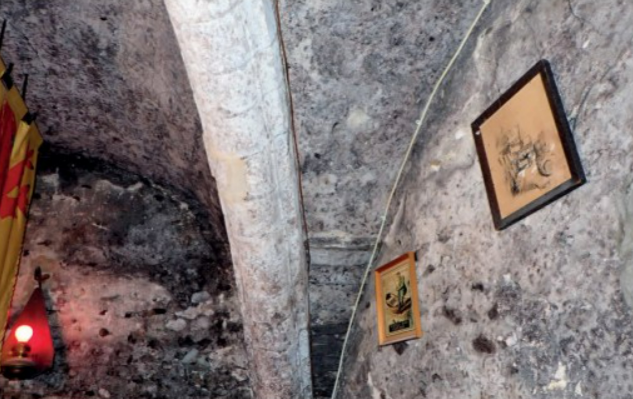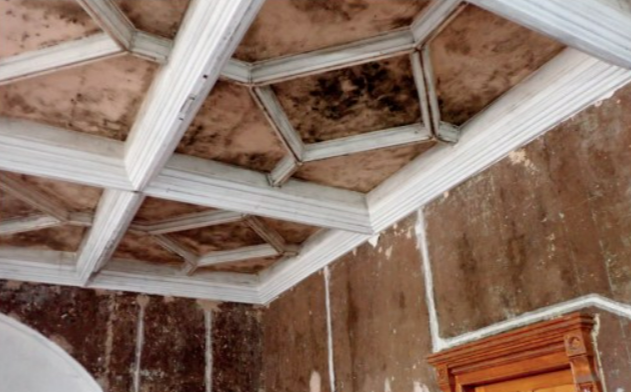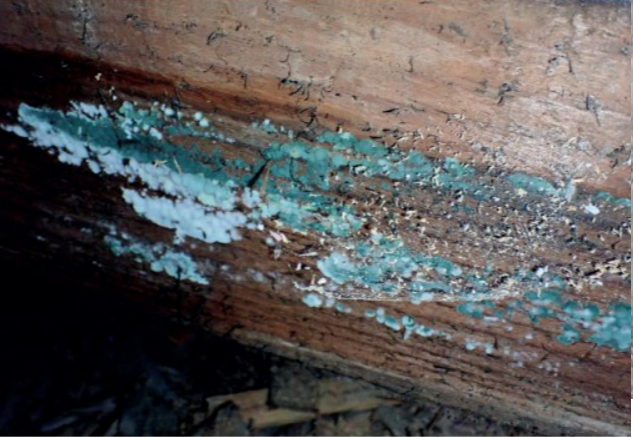Moulds in historic buildings
Meeting energy performance and building regulation requirements can have unintended consequences for traditionally constructed buildings and the health of their occupants.

|

|

|
| Extensive mould growth in a listed building | Extensive mould growth in a listed building | Mould contamination to historic timbers. |
Historic buildings and structures allow the moisture to breathe in and out. New regulations and codes for traditional structures, including EPC (energy performance certificate) requirements in particular, emphasise sealing historic buildings. Sealing these structures risks problems associated with excessive damp and humidity. Mould problems in both modern and historic buildings are mainly the result of defects in buildings, and lack of ventilation and maintenance.
Generally, historic buildings in England are not required to comply with current building regulations. However, substantial renovation or a change of use may cause an existing building to become subject to building regulations. The exact criteria are complex, and multiple parts of the building regulations may be involved, but the most relevant advice is contained in Approved Documents L1B and L2B, concerning conservation of fuel and power in existing dwellings and buildings other than dwellings respectively.
There are some well-defined exemptions from complying with energy-efficiency requirements, namely listed buildings (Grades I, II*, and II), buildings in conservation areas, and scheduled monuments. There are also some less well-defined classes of buildings where ‘special considerations’ apply. In historic buildings where measures are taken to improve energy efficiency, Approved Documents L1B and L2B provide guidance, as does Historic England’s Energy Efficiency and Historic Buildings.
A possible adverse consequence of improving energy efficiency in historic buildings is that the building will become less tolerant of problems and defects, as natural ventilation is likely to be reduced and humidity may increase. Unless renovations are well designed and well executed, they may lead to mould infestation and timber decay. The correct identification of the mould infestation and causation by an independent mycologist (mould specialist) is important, as not all infestations are equally toxic, pathogenic or destructive.
Extensive mould growth, including Stachybotrys chartarum (black or toxic mould), has been implicated in illnesses associated with living in damp homes. Black mould, a very cellulolytic species, can grow on wallpaper and plaster board that is very wet. Toxic mould has become a major issue for the USA insurance industry since 2001. In European and Scandinavian countries it is now poised to rival the mid-1980s asbestos crisis. There are several million-dollar claims for toxic mould against developers, landlords, homeowners’ insurance policies, surveyors and architects.
As the number and size of the claims and awards increases, the insurance companies are trying to stem their losses. There are now increasing numbers of legal claims relating to mould in the UK. This is mainly due to press and media coverage, and advertisements such as: ‘If you have respiratory problems, respiratory disease, a fungal infection or had your asthma worsened due to mould in your rented flat or house, you could be entitled to make a mould compensation claim for your illness.’
In the UK, insurance companies (which cover professional indemnity for work related to the building industry) have introduced a clause excluding mould and asbestos work. An exclusion means that the insurance company will not cover the losses or claims relating to the excluded event. Consequently, professionals evaluating a historic building for damp and mould infestation must work to the highest standards to ensure that their work is beyond criticism and advise the client to seek further advice from a qualified mycologist.
Mould spores and fragments are always present in the outdoor and indoor environments of our houses, offices and public buildings, and in both modern and historic buildings. Provided there is an adequate supply of nutrients, mould spores will grow where they land on places where there is excessive moisture and lack of ventilation, such as properties suffering from condensation, rising damp or penetrating dampness, or properties where leakage may have occurred. This is similar to the spores of dry rot or wet rot establishing extensive outbreaks on timber in historic buildings and causing extensive structural damage. Some moulds and decay fungi colonise wood with moisture content at or above 20 per cent, but appreciable development requires moisture contents at or above the fibre saturation point (28–32 per cent). Mould germination and proliferation require relative humidity at or above 70 per cent.
The dust and dirt normally present in most indoor spaces provide sufficient nutrients to support extensive microbial growth. Consequently the factor that limits microbial growth in a building, its systems and its surfaces is moisture. When this is present in sufficient quantity, microbial growth starts immediately. The most common fungi include Alternaria species, Aspergillus species, Aureobasidium pullulans, Cladosporium species, Mucor species, Penicillium species, Paecilomyces species, Rhizopus species, Trichoderma viride, Ulocladium species and yeasts.
Fungi can affect human health in three main ways. First, a very few are pathogens, causing disease, such as Aspergillus fumigatus causing Aspergillosis in humans, Mucor species causing Mucormycetes, Histoplasma capsulatum causing Histoplasmosis, Candida species causing Candida human infection and Cryptococcosis, usually caused by Cryptococcus neoformans. Humans are not the primary hosts of such species, and these are typically opportunistic infections of immunocompromised individuals. Second, the spores and/or cell fragments may be allergenic to some individuals. Third, some fungi, while not themselves pathogenic, give off waste products known as mycotoxins that are toxic to humans, such as mycotoxins produced by toxic mould.
Moulds and their metabolic by-products can be introduced into the indoor environment, causing a variety of allergic and irritant reactions in the occupants. Prolonged favourable environmental conditions in the indoor environment and in building materials lead to mould infestation. This may produce mycotoxins that have potentially serious health effects, such as mycotoxins from Stachybotrys chartarum in buildings damaged by fire and flood. Such buildings require careful monitoring for moisture, drying out and mould to avoid the development of mould and timber infestation.
Recent major flooding in the UK has raised concerns that climate change is causing increases in flood frequency and magnitude. Excess moisture on almost all indoor materials from flooding leads to growth of mould, fungi and bacteria. Building materials become saturated with moisture and indoor relative humidity levels become very high, at or above 95 per cent.
It is pointless to undertake extensive decontamination until conditions favourable to mould growth have been eliminated. Strategies for the control of mould contaminants in indoor air should be primarily focused on avoiding the conditions that provide a water source for materials or substrates, leading to the growth of mould spores, and secondarily on the containment and removal of such growth. The control of condensation and dew point (the temperature to which air must be cooled to become saturated with water vapor) in an indoor space is the most important single way in which the growth of moulds can be controlled.
Mould infestation in buildings is not usually readily visible to the naked eye. It is detected by monitoring, sampling, culturing and microscopic identification of hyphae and developed conidiophores, conidia and spores. Regardless of whether the mould infestation is visible or hidden, live or dead, moulds are equally important for the health of sensitive individuals.
The author has pioneered the use of an air sampler for carrying out non-destructive inspections of hidden cavities and voids in historic buildings. This machine extracts a known volume of air from a hidden void or cavity through existing holes in the fabric, or through small holes made discreetly. The collected sample can then be analysed for dry rot, wet rot and mould spores, for example. Normal background levels of spores would indicate a low risk of mould infestation and decay; high levels would indicate a problem in the void. That can be followed up using fibre-optic inspection and Resistograph decay detection drills to investigate hidden infestation and decay in timbers.
This article originally appeared in the Institute of Historic Building Conservation’s (IHBC’s) Context 172, published in June 2022. It was written by Jagjit Singh, director of Environmental Building Solutions and the editor of Building Mycology, Management of Decay and Health in Buildings (Taylor and Francis, 2016).
--Institute of Historic Building Conservation
Related articles on Designing Buildings
IHBC NewsBlog
Images from inside a Grade II listed hotel show the scale of its collapse
The Corbett Arms in Tywyn has fallen into serious disrepair.
Old Sarum fire in listed (& disputed) WW1 Hangar - Wiltshire Council has sought legal advice after fire engulfed a listed First World War hangar that was embroiled in a lengthy planning dispute.
UK Antarctic Heritage Trust launches ‘Virtual Visit’ website area
The Trust calls on people to 'Immerse yourself in our heritage – Making Antarctica Accessible'
Southend Council pledge to force Kursaal owners to maintain building
The Council has pledged to use ‘every tool in the toolbox’ if urgent repairs are not carried out.
HE’s Research Magazine publishes a major study of the heritage of England’s suburbs
The article traces the long evolution of an internal programme to research 200 years of suburban growth
IHBC Context 183 Wellbeing and Heritage published
The issue explores issues at the intersection of heritage and wellbeing.
SAVE celebrates 50 years of campaigning 1975-2025
SAVE Britain’s Heritage has announced events across the country to celebrate bringing new life to remarkable buildings.
IHBC Annual School 2025 - Shrewsbury 12-14 June
Themed Heritage in Context – Value: Plan: Change, join in-person or online.
200th Anniversary Celebration of the Modern Railway Planned
The Stockton & Darlington Railway opened on September 27, 1825.
Competence Framework Launched for Sustainability in the Built Environment
The Construction Industry Council (CIC) and the Edge have jointly published the framework.














